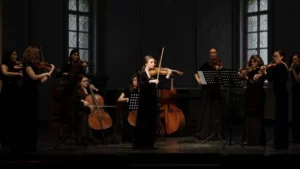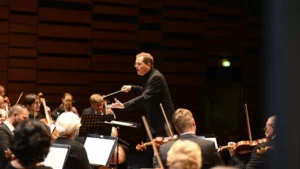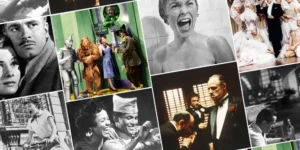The idea of associating music with a particular feeling or emotion is ingrained in our cultural DNA, as it reflects how civilizations have understood our innate reactions to specific tones or rhythms.
Although our biological response to music is natural, we cannot assume that the association of music and emotion is also natural.
This process has more to do with how culture has validated some of these associations through repetition, especially nowadays with mass media consumption, to the point that they are now almost indisputable.
By far the most simplistic correlation is the sadness/happiness duality associated with the minor and major scales respectively.
There is nothing intrinsic to either scale that makes them “sad” or “happy”, but culture has cemented this idea throughout history.
Without trying to deny the validating effect that culture has on the whole musical apparatus, we will try to expose these connections a little. We think it’s important to know how they can be used not to emphasize a cliché but rather to propel creativity through variation and juxtaposition.
Ethos doctrine
The origin of these cultural associations of music and emotion can be traced back to the ancient Greeks. Their literature reveals interesting correlations based on their ” Doctrine of the ethos“.
They believed that by choosing the right type of music (the scales in particular), the desired emotion would arise in the listener. Their vision was rooted in the realm of ethics, hence the name of the doctrine, and, as music played a major role in education for the ancient Greeks, this was of utmost importance. Of this vision is the intrinsic presence of “bad music” which would inevitably create an undesirable emotion in the listener, pushing him to adopt bad behavior.
Unfortunately, this side effect of “ethically correct” music persisted with any genre that subverted the status quo, whether it was jazz, rock, punk… the choice was yours.
Doctrine of Affections
Interesting theorizing occurred during the Baroque period and, this time, focusing more on the effect of the artistic product than on educating the mind of the listener. This theory was called the “Doctrine of the Affections”.
It was influenced by the Enlightenment trend of encyclopedic organization of universal knowledge, and it was widely accepted by many Baroque theorists and composers.
Here, the correlations were not just limited to scales or modes, but also to more complex musical devices involving rhythm, harmony, tempo, and texture.
Our modern (and less modern) philosophy regarding film notation has its roots in this type of association and, above all, in the use of music in the operas of this period. For Baroque composers who adhered to this theory, musical devices and their affective counterparts could range from large intervals that elicited joy or sadness through small intervals, to fury elicited by harsh harmony coupled with melody. Fast.
This leads us to what is known as “accompanying music”, which can simply refer to any music that supports a larger narrative, whether it is an opera, a television show, a a video game or a feature film.
Often the accompanying music refers to the background music, but it can also be the theme of a movie or the overture of an opera.
As long as there is a context outside the music itself, we are dealing with accompanying music, as opposed to “absolute music” or music that exists as such.
But in general, the most obvious situation where music supports or reinforces a certain emotion is when the music is used as an “underscore.”
This means that the music accompanies a scene usually accompanied by dialogue, but not always. Underscore music is often devoid of some of the more salient traits or elements that would bring the music to the fore, as this defeats its purpose.
Thus, it is common for there to be no discernible melody at all or, if there is melody, it is not very active so as not to conflict with the dialogue. Similarly, certain instruments with piercing timbres or frequencies are usually avoided in order to make the dialogue more intelligible.
The tradition of film music
After this little journey in the history of music, we have a nice context to answer our initial question.
In the tradition of film music, a few styles of composition have consolidated over the years to the point of becoming almost clichés today.
For example, for a high-speed car chase, one would expect a rhythmic ostinato (1) in the strings with heavy accents on the brass and percussion, or the use of pizzicato (2) strings and eccentric woodwind or xylophone melodies in a comic situation.
These associations are so rooted in our cultural symbolic universe that it can even be a challenge to avoid them while going in the same direction in the image.
Conclusion
As we have seen, the correlations between music and image (or drama) do not arise naturally, but through a repetitive process of legitimization derived from our cultural consumption.
It could go completely the other way in terms of the musical expectation on the part of the viewer, but it could also lead to comedic effect because of this cognitive dissonance.
If that’s your intention as a creator, then totally go for it! But if not, you should probably start by making at least some kind of reference to our cultural association of music and picture situation.
This will put the viewer in the right starting place to understand the piece in front of them. From there, the creativity of music, image, and their juxtaposition could take the viewer to an entirely unexpected place that does not give in to cliché and, at the same time, brings new elements into the mix.
Ultimately, any artistic endeavor should strive to offer something new or unexpected to your interlocutor.
And, because the effect of music on the overall storytelling is so powerful, choosing the right music isn’t something that can be done without careful thought and artistic intent.
(1) Ostinato comes from Italian and literally means “obstinate”. It refers to a repeating pattern both melodic and rhythmically. Usually, this motif is played in the background, on which other elements are added.
(2) Pizzicato comes from Italian and means to pluck the strings with the right hand.











